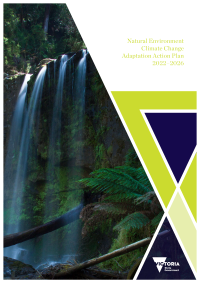The Natural Environment Climate Change Adaptation Action Plan is one of 7 plans prepared by the Victorian Government for 7 statewide systems. The plans will help ensure Victoria’s climate resilience, now and into the future.
The challenge
Victoria’s natural environment includes land-based ecosystems such as grasslands and forests, aquatic ecosystems such as rivers and wetlands, and coastal and marine ecosystems such as mangroves and sea-grass meadows. These ecosystems have immeasurable intrinsic value. They support life and provide some of our most basic needs, like clean water, productive soil, natural pest control, pollination, flood mitigation and carbon sequestration. Replacing the services that ecosystems provide would be extremely challenging and costly, if not impossible. Maintaining our natural environment for future generations is vital insurance in the face of ongoing change.
The effects of climate change already unfolding in Victoria – particularly more frequent fires, more intense droughts, reduced snowfall and increasing marine temperatures – are expected to worsen over time. These worsening impacts will increase the risk of habitat loss, species extinction and major ecosystem change.
Climate change also affects Aboriginal culture and practices, including through a loss of land and hunting grounds, changing fire regimes, and fewer animals in creeks and the sea.
Climate impacts can occur suddenly and cause large environmental shifts, including the collapse of ecosystems. This not only requires us to build natural ecosystems’ resilience but also consider options where impacts are significant or if the future is worse than anticipated. We need to identify potential tipping points and work to minimise consequences for our society and environment. We must ensure our decision-making methods are adaptive and flexible to accommodate uncertainty and changes in knowledge.
Work already underway
- Responding swiftly to the 2019–20 bushfires by coordinating recovery and protecting biodiversity through ground and aerial surveys to assess specific fire impacts, emergency extraction of critically threatened animals and plants, protecting ecological refuges, revegetation and reseeding.
- Supporting Traditional Owners to apply their ecological knowledge and lead cultural heritage and related activities in areas affected by the 2019–20 bushfires.
- Looking beyond single fire events to consider long-term strategies for maximising ecosystem resilience throughout Victoria and identifying priorities for reducing future fire risk to biodiversity.
- Providing grants to support fire-affected communities to learn about nature’s response and design and deliver projects that benefit local plants, wildlife and habitats.
- Using the adaptation pathways approach in Victoria’s Resilient Coast project.
Key priorities ahead
The next 5 years (2022–2026) will be focused on building the foundations of the practices, systems, and knowledge that will enable effective adaptation to climate impacts on Victoria’s natural environments. The plan will embed climate change adaptation into natural environment management by guiding adaptation planning in regional and place-based plans that manage specific areas and ecosystems, species and natural environment values.
- Assisting regional fire planners to include the climate adaptation lens in bushfire recovery planning.
- Including future weather scenarios in bushfire and forest modelling and planning.
- Creating a framework for monitoring and assessing emerging threats.
- Preparing a foundational guide to transformational adaptation in the natural environment.
- Identifying parts of Victoria that may be more vulnerable to climate impacts.
- Exploring opportunities to support behaviour change initiatives and build community understanding of and action for climate change adaptation.
- Considering the climate adaptation lens in the whole-of-sector bushfire management strategy and renewal of the Victorian Waterway Management Strategy.
- Supporting Traditional Owner outcomes and objectives, and prioritising self-determination in building the climate resilience of the natural environment system.
Case study: Responding to bushfires
Victoria is facing longer fire seasons, with up to double the number of high fire danger days. The 2019–20 bushfires resulted in a tragic loss of life and the devastation of wildlife and forests. More than 1.5 million hectares of Victorian land were burned and close to 400 homes were destroyed.
The air quality in many parts of Victoria became the worst in the world due to smoke haze.
Health services, water supply, roads and electricity infrastructure were disrupted. This affected businesses and community facilities, including schools.
Tackling the economic impacts
The bushfires cost the Victorian economy $2.1 billion. Around 70% of the total economic impacts have been attributed to the suppression of international tourism in Victoria over the coming years. The accommodation, food services, transport and construction sectors have been especially hard-hit.
The Victorian Government invested $250 million towards affected communities. This included establishing Bushfire Recovery Victoria to coordinate effective, timely support to help communities recover after major emergencies. The agency is now administering the cleanup and recovery program.
Financial support and relief programs were delivered for people and businesses after the bushfires to boost economic recovery and cushion employment losses in affected regions and industries.
Leveraging Victorian expertise in managing bushfires
Australia is recognised as a world leader in the science behind bushfire behaviour.
The PHOENIX RapidFire bushfire simulator was developed in Victoria and is used by land and fire managers to support fire management and decision making during bushfires.
Fuel management strategies are being delivered to reduce the risk of bushfires to communities through planned burning, slashing and mulching.
As climate change increases the hotter temperatures and drier conditions that contribute to bushfires, further research will ensure that climate scenarios are taken into account in the prediction and management of bushfire risk.
Further information
| The Natural Environment system Adaptation Action Plan will be delivered over the next 5 years (2022–2026), then updated every 5 years on the path to 2050. Read the full Adaptation Action Plan for the Natural Environment system |
Page last updated: 15/02/22
